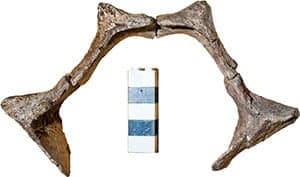Some 230 million years ago, a distant relative of the crocodile called an aetosaur roamed prehistoric Earth. Aetosaurs were about three to 15 feet long and covered head to toe with bony plates that served as a type of body armor. A series of recently discovered armor plates from North Carolina are distinct from any others previously discovered.
Fossils found at a clay-mining operation in the Triassic basins southwest of Raleigh show that the new species had a distinctive ring of “armor” around the reptile’s neck.
Dr. Andrew B. Heckert, a professor in Appalachian State University’s Department of Geology, identified the fossils, documented them as a new genus and species of the aetosaur and, along with staff members and volunteers from the North Carolina Museum of Natural Sciences and an expert from Scotland, named it Gorgetosuchus pekinensis.
Heckert is the lead author of an article published in The Journal of Vertebrate Paleontology about the discovery. Vincent P. Schneider, curator for the N.C. Museum of Natural Sciences, Dr. Nicholas C. Fraser from the National Museums of Scotland, and Richard A. Webb from the North Carolina Museum of Natural Sciences, were co-authors.
“Aetosaurs are an extinct group of reptiles from the Triassic Period from the lineage that eventually evolved into crocodiles. They were not dinosaurs, but superficially look like some of the much larger armored dinosaurs that would evolve later,” Heckert said. “Although aetosaur fossils have been found in North Carolina before, we were able to show that this particular specimen was distinct from any other known fossils in the world, and were able to assign a scientific name for the new genus and species.”
The fossil’s name reflects the distinctive spikes around the reptile’s neck and the rock formation in which the fossils were found.
Gorgetosuchus comes from gorget, which is the metal neck ring that knights wore for protection, he said, explaining the source of the new species’ name. Suchus is ancient Greet for crocodile, and pekinenis refers to the Upper Pekin Formation that runs through present-day central North Carolina where the fossils were uncovered.
“We knew this specimen was spiny and when we put the pieces together, we saw how some of the armor completely covered the neck,” Heckert said. “So this is the Pekin Formation neck collar crocodile.”
“This is the first time anyone has named an aetosaur from North Carolina,” Heckert said. “This one is new. It’s an interesting specimen, because parts of it seem to be very advanced for aetosaurs and parts of it are more primitive.”
The fossils were encapsulated in Triassic rock – large boulders and other material that had been removed from a mining operation to access mud used in brick making.
“Most of North Carolina’s Triassic fossil record has come from brick quarries (clay pits) or a few coal mines,” Heckert said. “There are constantly new materials coming out of the state’s active clay pits.”
The fossils were taken to the N.C. Museum of Natural Sciences, where they were carefully removed from the rock, photographed and prepared for analysis. A total of 19 specimens of spiny and armored scales, or osteoderms, were recovered from what would have been the reptile’s upper back, sides and neck.
Since the armor from different aetosaurs is distinct, many times only a few armor plates are needed to identify the reptile, Heckert said.
“A major review of aetosaurs that I co-authored in 2013 found that were approximately 22 genera and 26 species of aetosaurs, so every new one is a significant increase in the known diversity,” Heckert said.
“Aetosaurs are very strange animals and sort of an evolutionary experiment,” he added. “The more we look at the fossil record, one of the fun things is we see that over geologic time that some fossil crocodiles and their relatives were at one time herbivorous and in later rocks there are fossils of clam eating crocodilian with big, blunt teeth that clearly were used for crushing. So you never do know just what you are going to find.”

